Questions? Talk to an expert!


Projection whiteboards are a handy tool for office or classroom environments. This configuration makes it possible to draw and write directly onto the surface. These whiteboards are specially finished to be paired with a projector and therefore work much better for this purpose than your standard whiteboard which can often be too reflective and/or glossy for a projector.
DIY Projector Screens
A DIY projector screen is cheaper, allowing you to use that savings to upgrade your sound system, or projector. However a diy projection surface is rarely better than a quality store bought one.
Projector Screen Paint
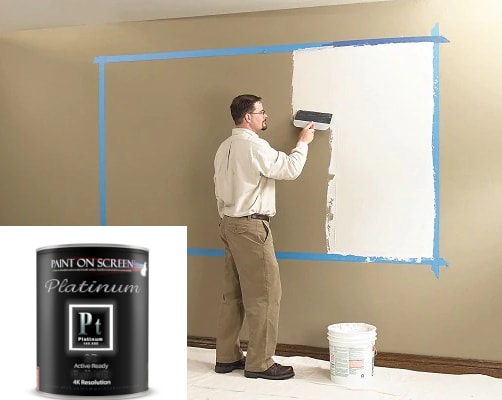
Projector Screen Paint is a fantastic, newer alternative to an actual movie screen, especially if cost is a factor. One gallon of projector screen paint can provide a surface area between 92" and 240" of diagonal viewing space.
And don't think you need to have permanent wall space in order to use this- you can always paint this onto a large board or other object to create your own portable surface.
Of course, the viewing quality won't be the same as an actual movie screen, but for basic needs, this is a great option. A normal projection screen in that size would cost hundreds just to ship alone and requires multiple people to install. Screen paint allows 1 person to use 1 gallon of paint and 1 roller to create an immersive projection experience.
Featured
Screen Type: | Paint |
Brand: | Paint on Screen |
Product Status: | Leaves Warehouse within 5-10 Business Days |
Gain: | 2.4 |
Product Line: | Paint on Screen |
Screen Type: | Paint |
Brand: | Paint on Screen |
Product Status: | Leaves Warehouse within 5-10 Business Days |
Gain: | 2.4 |
Product Line: | Paint on Screen |
Screen Type: | Paint |
Brand: | Paint on Screen |
Product Status: | Leaves Warehouse within 5-10 Business Days |
Gain: | 2 |
Product Line: | Paint on Screen |
Screen Type: | Paint |
Brand: | Paint on Screen |
Product Status: | Leaves Warehouse within 5-10 Business Days |
Gain: | 1.8 |
Product Line: | Paint on Screen |
Projector Screen Material
The projector screen material can make all the difference in the way your image appears. Different surfaces have different reflective properties. Some are cheap and some are quality. The screen materials have different textures and even come in different colors.
What Are Projector Screens Made Of?
Most projector screens are made of vinyl, high grade plastic, spandex, rubber and polyester fabric. You can also find ones made using PVC, canvas and fiberglass. The best projector screens are made using vinyl or spandex.
Regardless of what material is used to manufacture a movie screen, it is coated with magnesium carbonate, titanium dioxide or barium sulfate for enhanced visibility of the light which is directly related to the amount of light which is getting reflected from the surface. When the motion picture industry first took off there was actual silver embedded in the material to make it more reflective. This is where we get the term “the silver screen”.
Projector Screen Colors
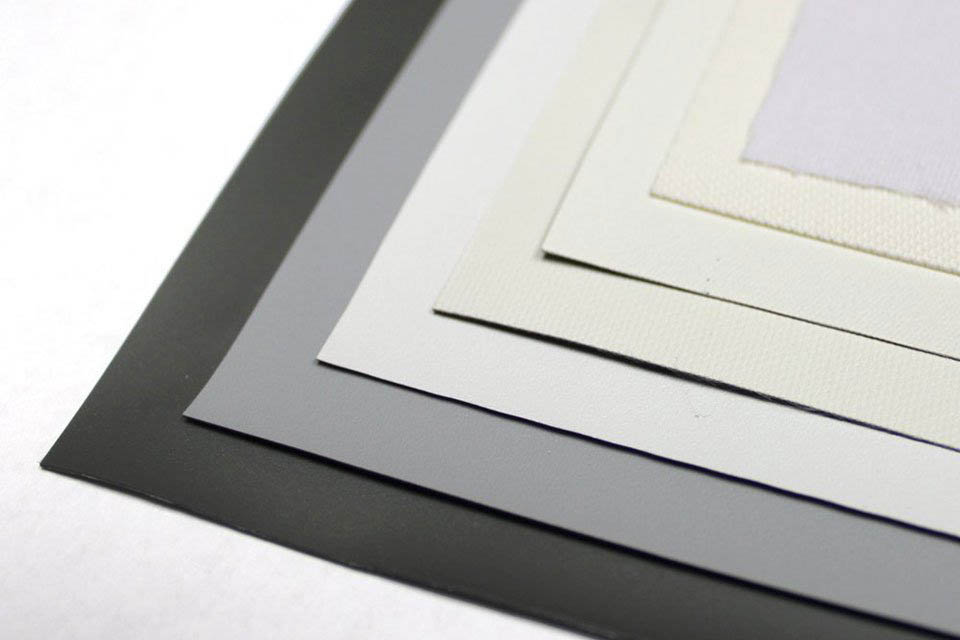
Almost all projection screens come in one of three colors: white, gray and black. Each one has it’s advantages and disadvantages.
White Screen
A white projection screen will always be the best option for a room that is totally dark (full light controlled) It will also allow you to watch it from any angle as most gray and black screens have a smaller viewing cone. The white screens are also relatively less expensive.
White screens are also typically better for offices because most content projected in an office has white background. Projecting on a non-white surface just wouldn’t quite look right.
Gray Screen
Gray projection screens tend to have ambient light rejecting properties which allows them to be used in the daylight. They will also have better, richer colors. This improved contrast is why many manufacturers refer to their gray screens as "high-contrast" models.
The only downside to grey screens is that depending on the surface, they may have a smaller viewing cone.
Black Screen
Much like the grey ones, black projector screens tend to be ambient light rejecting. Where they really stand out is by having a black surface black movie screens give you the darkest darks and black levels. The down side to black screens is that their white levels are typically somewhat less accurate.
What Is The Best Color For A Projector Screen?
The best projector screen color really depends on where you will be using it, how much light the room has and what you’ll be using it for.
Screen Texture
When it comes to projector screen texture you ideally want a textureless surface. This will give you the best picture quality.
Screen Gain
A projector screen works by reflecting the light back from your projector to your audience's eyes.
The brightness of the image reflected back off of the display's surface is measured in units of "gain", gauging the reflectivity of that surface.
The gain number represents a ratio of light that is reflected back from a surface from a light source.
A screen with a gain measurement of greater than 1.0 infers that the image projected back off of the surface is brighter than the image being projected at the surface.
For example; a movie screen with a gain of 1.5 will project back the light 1.5x brighter than the light being projected at the screen. A 1,000 lumen projector aimed at a screen with 1.5 gain will be perceived at 1,500 lumens. The display achieves this by focusing the light into a more narrow reflective angle, instead of uniformly reflecting the light in all directions. This is why higher gain screens have a smaller viewing angle.
A projector screen with a gain measurement of .8 will reflect back at 80% of the original brightness. That same 1,000 lumen projector will be viewed by the audience at only 800 lumens.
While it might seem like you’d always want a higher gain, brighter doesn’t always mean better. A projector screen with a lower gain has a wider viewing angle so if you have a wider space a lower gain would be better. Lower gain screens also help prevent hotspotting and reflect colors more accurately. Lower gain screens also help to bring out more vivid blacks and enhance a projector's native contrast ratio.
Special Features
Some screens are constructed with special features. These refer to a unique characteristic of a screen’s design, implemented to either improve the projector’s performance or to add further utility to the screen. These premium features will help take your home theater experience to the next level.
Ambient Light Rejecting
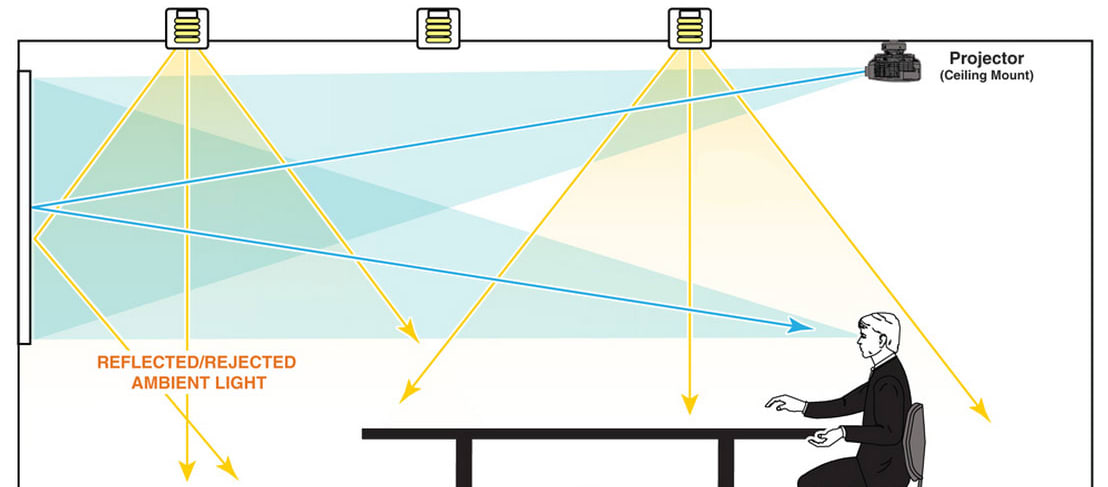
Any light source other than your projector threatens to wash out the image on your display surface. Ambient Light Rejecting or ALR projector screens have a surface that prevents ambient light from washing out a projected image. They achieve this by reflecting the light away from the source using microscopic sawtooth teeth.
These screens are best suited for use in a multi purpose or living room where daytime watching is necessary and black out curtains aren’t available.
You can learn more about ambient light rejecting screens here.
Featured
Special Features: | Ambient Light Rejection, Ultra Short Throw |
Supported Resolution: | 4K |
Screen Type: | Fixed Frame, Ultra Short Throw |
Mount Type: | Wall |
Format: | HDTV [16:9] |
Brand: | Formovie |
Viewable Diagonal in.: | 100 |
Viewable Width in.: | 87 |
Viewable Height in.: | 49 |
Product Status: | In Stock |
Gain: | 1.0 |
Surface Color: | Gray |
Front/Rear Projection: | Front |
Special Features: | Ambient Light Rejection, Ultra Short Throw |
Supported Resolution: | 4K |
Screen Type: | Fixed Frame, Ultra Short Throw |
Mount Type: | Wall |
Format: | HDTV [16:9] |
Brand: | Spectra Projection |
Viewable Diagonal in.: | 100 |
Viewable Width in.: | 87 |
Viewable Height in.: | 49 |
Product Status: | In Stock |
Gain: | 0.5 |
Surface Color: | Gray |
Product Line: | Vantage |
Front/Rear Projection: | Front |
Projection Surface: | Vantage UST 0.5 |
Special Features: | Ambient Light Rejection, Tensioned, Ultra Short Throw |
Supported Resolution: | 4K |
Screen Type: | Electric, Ultra Short Throw |
Mount Type: | Floor |
Format: | HDTV [16:9] |
Brand: | Spectra Projection |
Viewable Diagonal in.: | 120 |
Viewable Width in.: | 104.6 |
Viewable Height in.: | 58.8 |
Product Status: | Leaves Warehouse within 2-3 Weeks |
Gain: | 0.7 |
Surface Color: | Gray |
Case Color: | Black |
Product Line: | Phoenix |
Front/Rear Projection: | Front |
Projection Surface: | Phoenix |
Special Features: | Ambient Light Rejection, Ultra Short Throw |
Supported Resolution: | 4K |
Screen Type: | Fixed Frame, Ultra Short Throw |
Mount Type: | Wall |
Format: | HDTV [16:9] |
Brand: | Spectra Projection |
Viewable Diagonal in.: | 120 |
Viewable Width in.: | 104.6 |
Viewable Height in.: | 58.8 |
Product Status: | Leaves Warehouse within 4-6 Weeks |
Gain: | 0.5 |
Surface Color: | Gray |
Product Line: | Vantage |
Front/Rear Projection: | Front |
Projection Surface: | Vantage UST 0.5 |
Acoustically Transparent
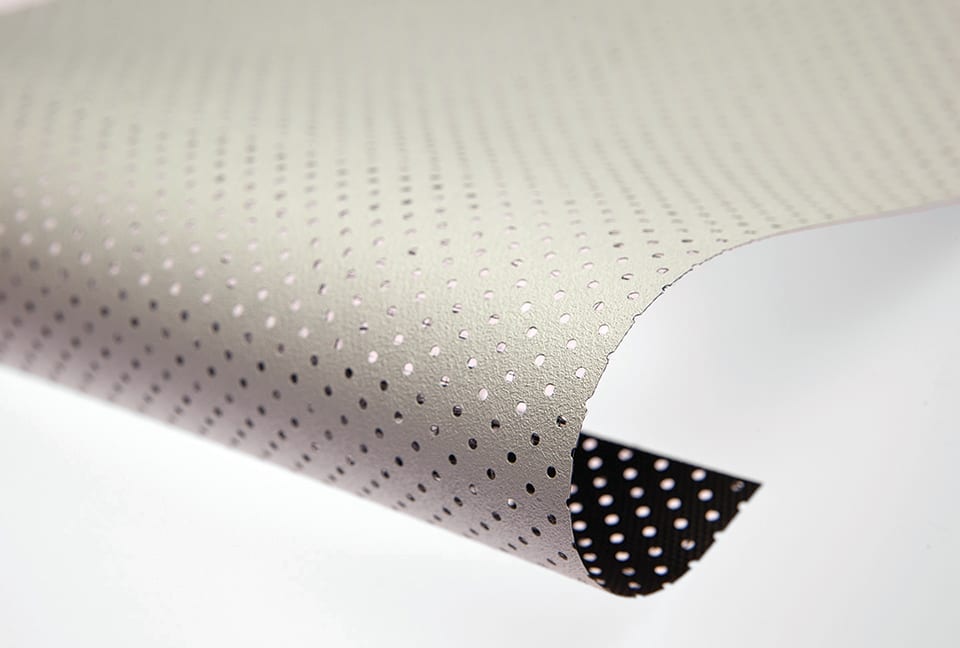
An acoustically transparent projection screen allows sound to pass through the screen material allowing for speakers to be placed behind the screen, maximizing the viewing and listening experience. There are two types of acoustically transparent cinema screens; Woven and Perforated.
Woven screens use a porous surface (like a bed sheet) which allows sound to pass in and out. There are two disadvantages to this design type: You lose more light and it does not render 4K as well due to the textured surface. If you are planning to have your screen come down in front of a TV or reflective surface woven screens are the better option.
Perforated screens have very tiny holes throughout the surface that allow sound waves to pass through. This allows you to lose less light than that of a woven screen and can render a 4K resolution.
Featured
Special Features: | Acoustically Transparent |
Supported Resolution: | 1080P |
Screen Type: | Fixed Frame |
Mount Type: | Wall |
Format: | HDTV [16:9] |
Brand: | Draper |
Viewable Diagonal in.: | 100 |
Viewable Width in.: | 87 |
Viewable Height in.: | 49 |
Product Status: | Leaves Warehouse within 5-10 Business Days |
Gain: | 1.0 |
Surface Color: | White |
Product Line: | Cineperm |
Front/Rear Projection: | Front |
Projection Surface: | ClearSound NanoPerf XT1000V |
Special Features: | Acoustically Transparent |
Supported Resolution: | 1080P |
Screen Type: | Fixed Frame |
Mount Type: | Wall |
Format: | Widescreen [16:10] |
Brand: | Draper |
Viewable Diagonal in.: | 109 |
Viewable Width in.: | 92 |
Viewable Height in.: | 58 |
Product Status: | Leaves Warehouse within 5-10 Business Days |
Gain: | 1.0 |
Surface Color: | White |
Product Line: | Edgeless Clarion |
Front/Rear Projection: | Front |
Projection Surface: | ClearSound NanoPerf XT1000V |
Special Features: | Acoustically Transparent, Ambient Light Rejection, Tensioned |
Supported Resolution: | 4K, 8K, 16K |
Screen Type: | Electric |
Mount Type: | Wall and Ceiling |
Format: | HDTV [16:9] |
Brand: | Stewart Filmscreen |
Viewable Diagonal in.: | 110 |
Viewable Width in.: | 96 |
Viewable Height in.: | 54 |
Product Status: | Leaves Warehouse within 4-6 Weeks |
Gain: | 1.1 |
Surface Color: | Gray |
Case Color: | Black |
Product Line: | Luxus |
Front/Rear Projection: | Front |
Projection Surface: | FireHawk Perf |
Special Features: | Acoustically Transparent, Ambient Light Rejection, Tensioned |
Supported Resolution: | 4K, 8K, 16K |
Screen Type: | Electric |
Mount Type: | Wall and Ceiling |
Format: | HDTV [16:9] |
Brand: | Stewart Filmscreen |
Viewable Diagonal in.: | 110 |
Viewable Width in.: | 96 |
Viewable Height in.: | 54 |
Product Status: | Leaves Warehouse within 4-6 Weeks |
Gain: | 1.1 |
Surface Color: | Gray |
Case Color: | White |
Product Line: | Luxus |
Front/Rear Projection: | Front |
Projection Surface: | FireHawk Perf |
Rear Projection
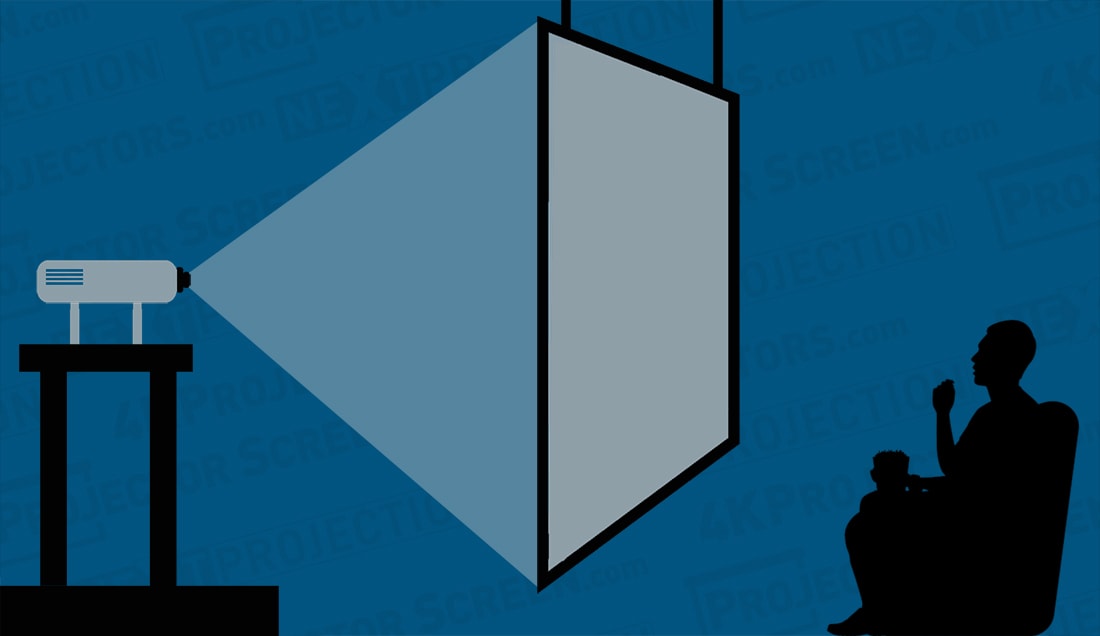
Rear projection requires that the projector be positioned behind the screen. Rear projection surfaces are partially translucent.
Unlike front projection, rear projection surfaces are always tensioned by default. Because this configuration requires that the projector be placed behind the screen (facing the audience) one of the disadvantages of rear projection is that it requires more space than front projection.
Because of this, two way projection screens are less commonly found in home cinema rooms.
However, there is an advantage to rear projection over front projection - there’s less chance of someone obstructing the projected image. Rear projection is most commonly used in professional applications like trade-shows and large theaters.
Tensioned
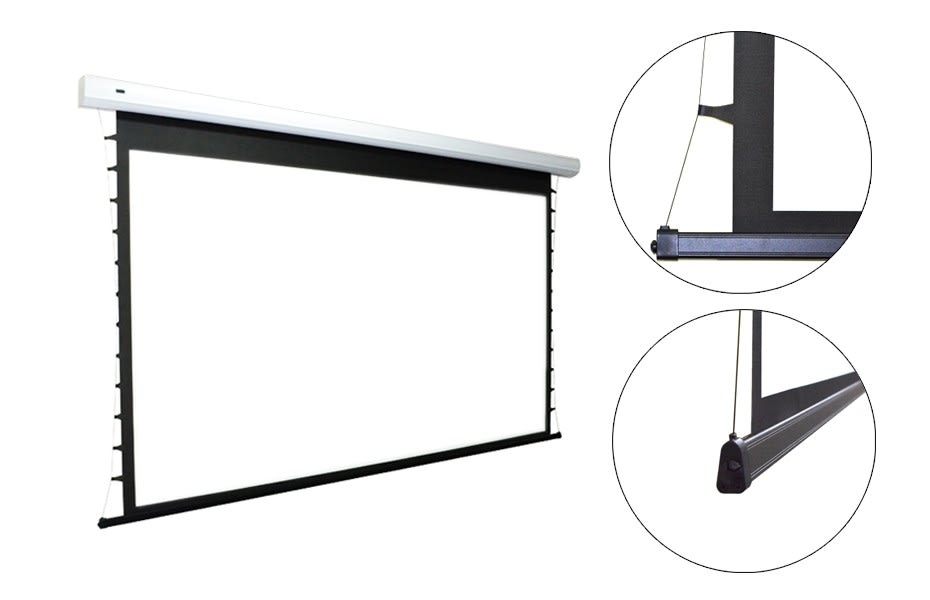
A tensioned projector screen refers to an electric or manual screen that has rods or a wire that pulls the screen material to present a flatter more uniform projection surface. The tensioning feature eliminates the occasional creasing, waviness or other imperfections a non tensioned screen might have. Tensioned electric screens are also necessary to support 4K and above resolutions.
Fixed frame screens are tensioned by default.
One of the pain differences you’ll find between cheap projector screens and quality is that premium ones will be tensioned giving you a much better picture quality.
Ultra Short Throw
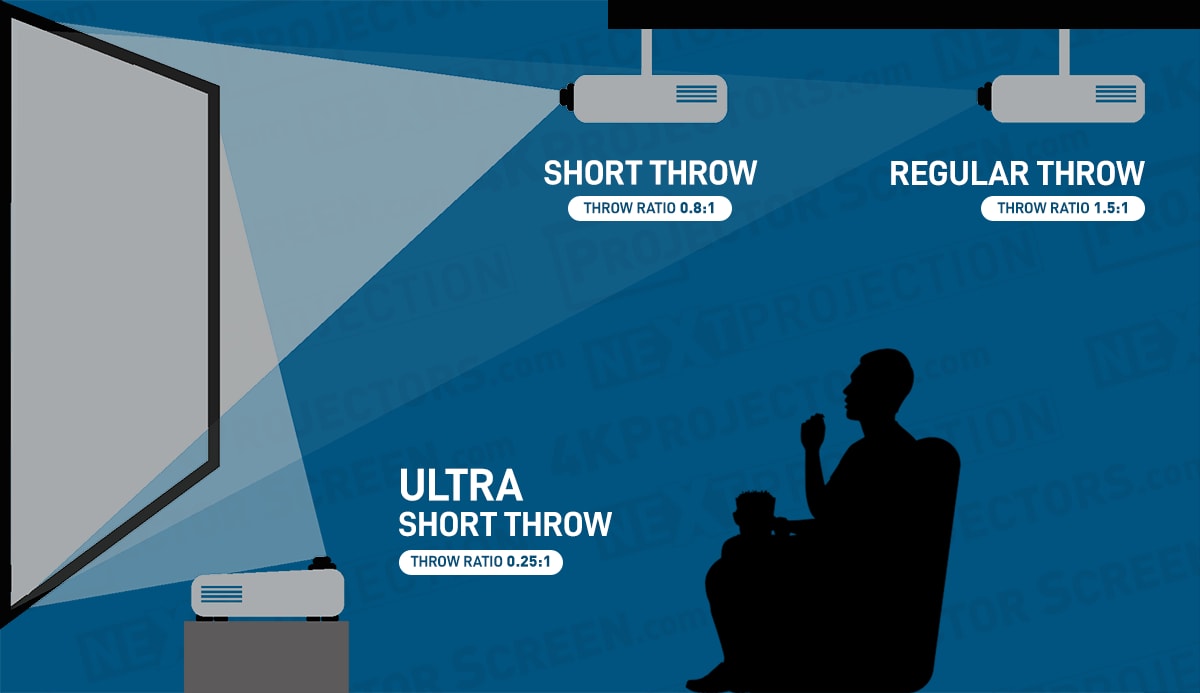
An Ultra Short Throw projector screen is specially designed to enhance the image from an ultra short throw projector or laser TV. These projectors use special wide angle lenses and mirrors to “throw” the image onto the screen from a very short distance.
To help these UST projectors, the UST screens are ambient light rejecting and reflect light in such a way that only the light from the projector is reflected back to the viewer giving you a much brighter image.
Featured
Special Features: | Ambient Light Rejection, Ultra Short Throw |
Supported Resolution: | 4K |
Screen Type: | Fixed Frame, Ultra Short Throw |
Mount Type: | Wall |
Format: | HDTV [16:9] |
Brand: | Formovie |
Viewable Diagonal in.: | 100 |
Viewable Width in.: | 87 |
Viewable Height in.: | 49 |
Product Status: | In Stock |
Gain: | 1.0 |
Surface Color: | Gray |
Front/Rear Projection: | Front |
Special Features: | Ambient Light Rejection, Ultra Short Throw |
Supported Resolution: | 4K |
Screen Type: | Fixed Frame, Ultra Short Throw |
Mount Type: | Wall |
Format: | HDTV [16:9] |
Brand: | Spectra Projection |
Viewable Diagonal in.: | 100 |
Viewable Width in.: | 87 |
Viewable Height in.: | 49 |
Product Status: | In Stock |
Gain: | 0.5 |
Surface Color: | Gray |
Product Line: | Vantage |
Front/Rear Projection: | Front |
Projection Surface: | Vantage UST 0.5 |
Special Features: | Ambient Light Rejection, Tensioned, Ultra Short Throw |
Supported Resolution: | 4K |
Screen Type: | Electric, Ultra Short Throw |
Mount Type: | Floor |
Format: | HDTV [16:9] |
Brand: | Spectra Projection |
Viewable Diagonal in.: | 120 |
Viewable Width in.: | 104.6 |
Viewable Height in.: | 58.8 |
Product Status: | Leaves Warehouse within 2-3 Weeks |
Gain: | 0.7 |
Surface Color: | Gray |
Case Color: | Black |
Product Line: | Phoenix |
Front/Rear Projection: | Front |
Projection Surface: | Phoenix |
Special Features: | Ambient Light Rejection, Ultra Short Throw |
Supported Resolution: | 4K |
Screen Type: | Fixed Frame, Ultra Short Throw |
Mount Type: | Wall |
Format: | HDTV [16:9] |
Brand: | Spectra Projection |
Viewable Diagonal in.: | 120 |
Viewable Width in.: | 104.6 |
Viewable Height in.: | 58.8 |
Product Status: | Leaves Warehouse within 4-6 Weeks |
Gain: | 0.5 |
Surface Color: | Gray |
Product Line: | Vantage |
Front/Rear Projection: | Front |
Projection Surface: | Vantage UST 0.5 |
Curved Projector Screen
As the name implies, a curved screen is slightly curled. A curved projection screen has several benefits for home cinema. The curved edge allows your peripheral vision to become more involved and immersed than the viewing on a flat screen.
This benefit is mostly seen when the curved screen is set up as a 2:35 to 1 or 2:4 to 1 aspect ratio. This is known as anamorphic widescreen and is most commonly seen in commercial movie theaters. You can also use curved screens using a Panamorph lens attachment to your projector.
Screen Format

A screen’s format can be best understood as the specific rectangular shape of the screen. Sometimes this is referred to as the projector screen’s aspect ratio. It tells you the ratio of width to height.
16:9 Projector Screen (HDTV Format)
The most common aspect ratio in home theater today is 16:9 (HDTV format). This is the aspect ratio that modern-day television content is broadcasted in. When you watch programs on Netflix, Amazon Prime, YouTube, Hulu, etc, or play video games, the format you will most likely encounter is 16:9.
If you plan to watch both TV and movies a 16:9 screen is the recommended aspect ratio.
16:10 (Widescreen)
Most computer screens are 16:10 format. The distinction between 16:9 and 16:10 is minimal. While the 16:9 shape has 9 units of height for every 16 units of width, 16:10 has 10 units of height for every 16 units of width.
Without closer inspection, they tend to look the same. However, their applications tend to be different. Since computers display in 16:10, this format is often the preferred choice in professional applications (conference rooms, board rooms, trade shows) as it allows you to get slightly more information on the screen than 16:9.
So if you're using your projector for business purposes a 16:10 projector screen is what we'd recommend.
Cinemascope (2.35:1 And 2.40:1)
2.35:1 Aspect Ratio
Classic films were most often shot using a 2.35:1 Cinemascope aspect ratio. So if you are a cinephile wanting the vintage movie theater experience in the privacy of your own home without the black bars, a 2.35:1 Cinemascope format is the way to go.
2.40:1 Aspect Ratio
For modern movie cinephiles, 2.40:1 Cinemascope is the way to go because most current films are shot with the 2.40:1 aspect ratio. So if you are wanting the contemporary movie theater experience in your own home theater, get a 2.40:1 Cinemascope projector screen.
4:3 (Video Format)
Video format is the original TV shape that was popular before many years ago, back when the TV was not a flat-screen - the old tube television, VHS and low resolution computer outputs.
The reason why 4:3 Video format still exists in the projection screen world is because it is a versatile design, not to mention that a lot of content still exists in its original 4:3 shape. In the case of 4:3 there are 4 units of width for every 3 units of height.
1:1 (Square Format)
While there’s almost no video content in square format, there is a reason that this format is still popular: for screens that can be adjusted, square format can accomplish all the other formats.
For example, if you’re using a tripod screen, you can lock the height of the screen at various points in order to achieve various aspect ratios.
Another reason square format screens still exist is that it is optimal for slide projectors or overhead projectors.
Masking (Multi Format)
A multi-format screen allows for more than one aspect ratio to be offered by employing a masking device. While most screens do not offer this feature, there are few select displays which do.
There are two kinds of masking: horizontal masking and vertical masking. In the case of horizontal masking it is the width of the screen that remains constant, and in vertical masking it is the height of the screen that remains constant. For example if you are watching cinemascope content on a 16:9 screen the height of the screen can be reduced to fit the aspect ratio with horizontal masking.
Projector Screen Size
Whoever said “size doesn’t matter” has never witnessed the glory of a 4K 120 inch projector screen in their home.
The size of the screen, both its width and height, will be limited by the dimensions of the wall you plan to install it on.
How Do You Measure The Screen Size?
Because there are so many different aspect ratios it would be difficult to compare a screen’s height or width. That’s why projector, television, computer and even phone screens are typically measured using the diagonal. This also allows you to compare surface areas much more easily.
What Size Projector Screen Should I Get?
The projector screen size you should get depends on what it’s being used for.
Some people’s personal preference is to have the largest screen possible while others prefer to have the optimal size to distance ratio for their screen.
Size For Home Theaters
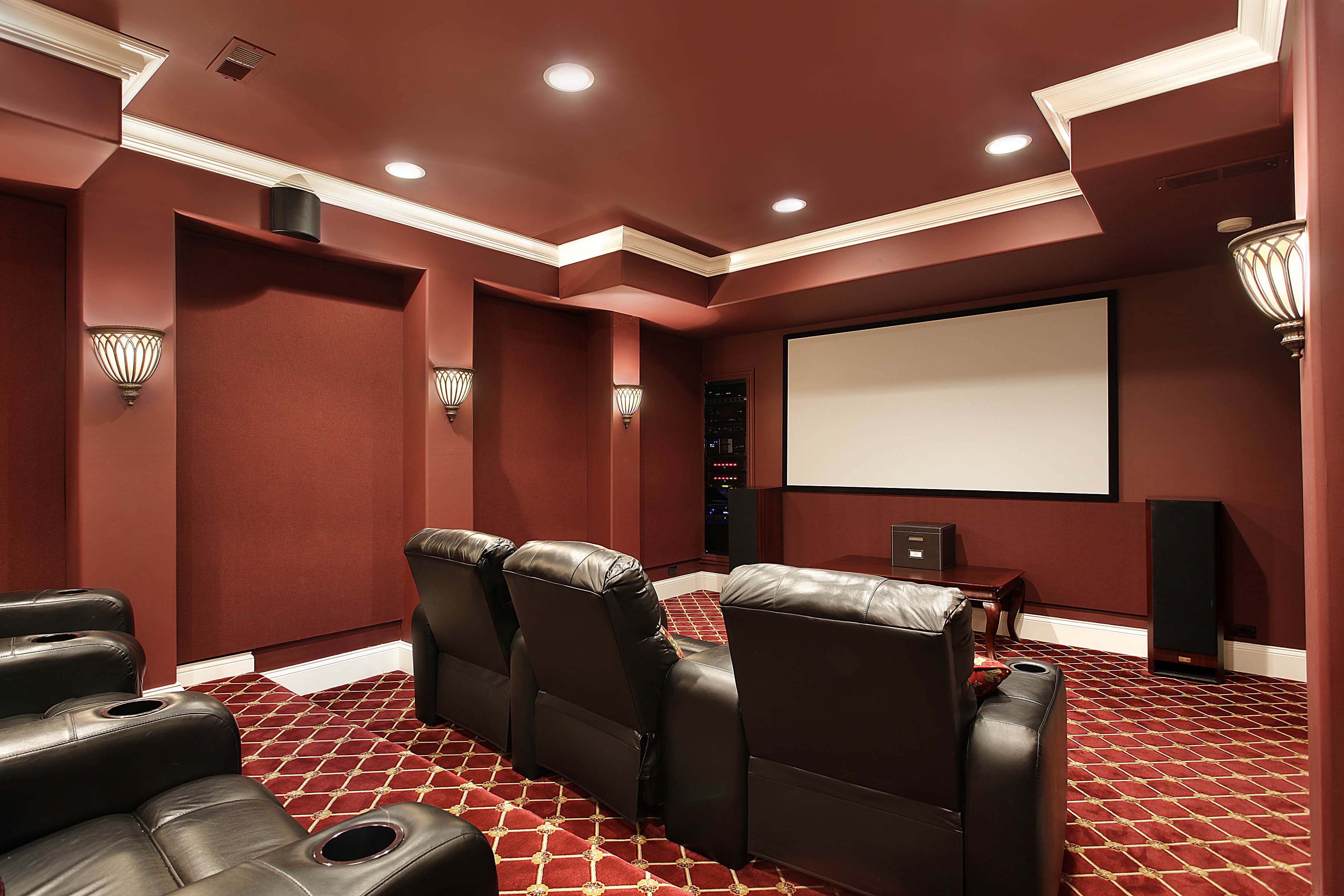
If you’re planning to use it in your home theater you likely want a screen between 100 inches and 150 inches. This of course depends on the size of your media room and where you’d be sitting.
Size For Large Venues

If you’re planning to use it for a larger space like a church projector screen or other large venue you’ll likely want to get a screen over 150 inches.
How Much Does A Projector Screen Cost?
The cost of a projector screen can run from $50 for a cheap projector screen to $4000 for a premium home theater screen to tens of thousands of dollars for very large screens that you would find in a commercial movie theater.
When it comes to quality items that are worth getting, most home cinema screens cost between $400 and $4000.
The projection screen price is determined by a number of factors like the size of the screen, the type of screen it is, the type of surface it is and the special features.
Why Do Premium Projector Screens Cost So Much?
While you can find a cheap projector screen for under $100, these screens are little better than a bed sheet and about the size of a hand towel.
A premium cinema screen on the other hand is a scientifically engineered piece of technology.
- They’re made with higher grade parts and longer lasting material.
- They give you significantly better picture quality.
- They bring out the best in your projector.
- They have better warranties and lower defect rates.
Is A Projector Screen Worth It?
Yes projector screens are worth it! While there might be some initial sticker shock, when you see the image projected on a 120 4K projector screen you instantly know that your screen was one of the best purchases you’ve ever made.
Where Should You Put Your Projector Screen?
Determining where to place your projector screen is crucial for achieving optimal image quality and viewing comfort. Here are some quick tips for screen placement:
- Central Location: Position the screen in the center of the wall for balanced viewing angles from all seating positions.
- Avoid Direct Sunlight: Choose a location where the screen won't be affected by direct sunlight or harsh artificial lighting, as this can wash out the image and reduce contrast.
- Consider Viewing Distance: Ensure there's enough distance between the screen and the seating area to accommodate comfortable viewing. Follow recommended guidelines based on screen size and resolution for optimal viewing angles.
- Minimize Obstructions: Avoid placing the screen where it may be obstructed by furniture, columns, or other obstacles that could interfere with the projection or viewing experience.
- Room Acoustics: Take into account the room's acoustics when positioning the screen. Avoid placing the screen too close to reflective surfaces such as windows or bare walls, which can cause audio reflections and distortions.
- Screen Height: Mount the screen at an appropriate height for clear visibility from all seating positions. The bottom third of the screen should be at eye level when seated for comfortable viewing.
- Accessible Power Outlets: Ensure easy access to power outlets for the projector and any motorized screen mechanisms if applicable.
- Consider Screen Type: Depending on the screen type (fixed-frame, retractable, motorized), allow space for installation and operation, including clearance for wall or ceiling mounts.
- Test Projection Placement: Before finalizing screen placement, conduct a test projection to ensure optimal image quality, brightness, and alignment from the desired viewing positions.
By following these placement tips, you can choose the best location for your projection screen to create an immersive and enjoyable viewing experience for yourself and your audience.
Where Should You Put Your Projector Screen In Your Home Theater?
The general recommendation, for where to put your projector screen in a home theater is 10“ to 12” of screen diagonal for each foot of viewing distance. That distance is eyes to screen. It's a pretty simple calculation.
If you will be sitting 10' away, then a 100“ to 120” diagonal is ‘typical’. 100“ would give you the center of theater feel. 120” is a bit closer than the center of the theater. It comes down to personal preference.
There is usually only one wall in your media room that the video screen would work best on. You should try to put the projection surface on a wall that has no direct light shining on it. The more light that hits the display surface, the more washed out the picture on it will look.
If the light in the room cannot be completely controlled, you might want to consider an ambient light rejecting screen.
Our experts suggest the bottom of the screen be between 2 to 3 feet off of the floor. This allows you to have the optimal viewing height.
Of course, this depends on the size of your screen and the wall you’re placing it on.
If you have multiple rows of theater seating in your cinema room, you may need to go a bit higher to keep clean lines of sight for people sitting behind the first row.
Also make sure to take into account anything that will sit underneath the display, like a center speaker or an entertainment center.
Viewing Angles
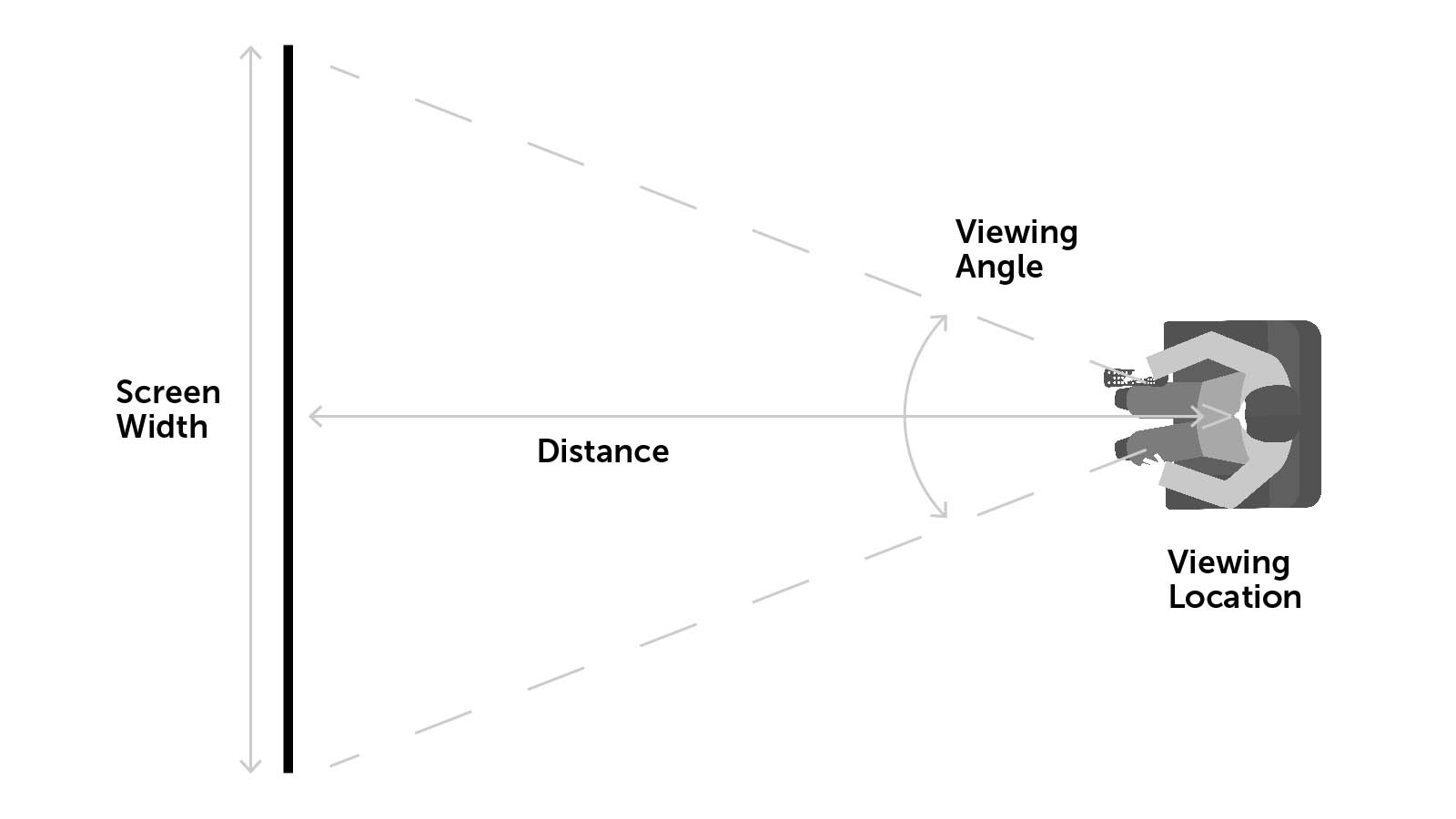
One thing you need to take into account when buying a projector screen are the viewing angles. The viewing angle is the angle the screen traverses in the viewer’s front vision from the far left of the screen to the far right.
It’s recommended that you have a viewing angle between 30 to 40 degrees for optimal viewing. At wider angles the image will appear dimmer and washed out because the light reflecting of the screen isn’t reflecting as much at that angle.
Some projection screens have wider viewing angles than others. So if you’re planning to use your display in a wider room, you need to make sure it has a wider viewing angle.
Sightlines
If you have more than one row in your home movie theater, the rows behind the first could be blocked by heads of the viewers in the first. You can use risers or horizontally stager the seating layouts. The other option you have is to place the screen higher on the wall.
Projector Screen Brands
At ProjectorScreen.com we only carry the highest quality film screen brands. Get to know some of the brands we have on our website.
- About the company: Screen Innovations is not your traditional screen. Since 2003 SI have designed, engineered, and hand-built projection screens for the custom integrator from their facility in Austin TX, USA.
- Price range: $1,000-$55,000
- Specialty: 4K+ resolution projection screens, best known for their Black Diamond ambient light rejecting screens
- Custom screens available
- Made in the USA
- About the company: Stewart has been leading the projector screen industry for over seventy years. All Stewart screens are made in the USA and can provide the largest seamless screen of any manufacturer. What's even more impressive is that Stewart Filmscreen is a family-owned company still after all these decades.
- Price range: $1,300-$15,000
- Specialty: 4k-16k+ resolution projector screens, best known for their StudioTek reference screen materials
- Custom screens available
- Made in the USA
- About the company: Elite Screens started out as a relative newcomer in the industry over 10 years ago. Since then, they've firmly established themselves as one of the audio-visual world's most recognizable brands when it comes to projection screens. They are especially well-known for producing products that are highly affordable on even tight budgets, but which sacrifice nothing when it comes to precision and efficiency.
- Price range:$120-$9,000
- Specialty: Economical projector screens
- About the company: Founded in Warsaw Indiana in 1909, Da-Lite was there at the beginning of the moving picture industry. In what has now been more than a century of projector screen development, Da-Lite has been at the cutting edge with each and every technological twist in turn that has taken place.
- Price range: $130-$38,000
- Specialty: Projector screens for K-12, Higher Ed, House of Worship and other commercial applications
- Custom screens available
- Made in the USA
- About the company: Draper Inc is one of the preeminent manufacturers of projector screens based in the USA. Based out of Spiceland Indiana. Draper is one of the longest lasting (and family-owned) manufacturers in the country today. Draper entered the projector screen field toward the end of the 1950s. Their displays are frequently found in classrooms and boardrooms across the country.
- Price range: $120- $24,000
- Specialty: Projector screens for K-12, Higher Ed, House of Worship and other commercial applications
- Custom screens available
- About the company: Spectra Projection is a relatively new comer to the world of projection, but don't let that fool you these innovators make high quality screens for an affordable price. They were the first to manufacture 150 inch ultra shrot throw projection screens.
- Price range: $1300-$5000
- Specialty: High quality, affordable ultra short throw projector screens
- About the company: Since 2004 Vividstorm has been bringing high-quality products, great customer service and an unparalleled value to the projection screen market. They saw a lack of motorized ultra short throw cinema screens and filled that gap with affordable floor rising models that feature high performance ambient light rejecting surfaces.
- Price range: $1800-$2300
- Specialty: Floor rising retractable ultra short throw screens
- About the company: Grandview Screen is a global leading projection screen manufacturer, offering a complete line of internationally recognized and regarded screens. Decades of engineering and production experience; pioneering the frontier for Projection Screens.
- Price range: $900-$1700
- Specialty: The most economical true 4k projection surfaces
- About the company: Since they were first established in 2006, Elunevision has been a consistent and ongoing source of innovative, fresh, reliable audio-visual product lines capable of satisfying even the most discriminating consumer.
- Price range: $1100-$6000
- Specialty: Economical 4k projection screens
What Is The Best Screen Brand?
There are a number of projector screen manufactures but deciding which is the best projector screen brand is somewhat subjective. Some brands are better at certain features than others.
If you want to buy the best projection screen there are a few attributes you should look for.
Where Is The Screen Made?
You want to look for a brand that manufacturers in the United States. When you buy a made in the USA projector screen, you can be more confident that you’ll be getting a higher quality screen built with better quality materials and components so they’re likely to last longer.
Another advantage is that they’re more likely to arrive without damage because they don’t have to come from overseas. This is the reason American screen manufacturers are able to offer more substantial warranties.
Projector Screen Warranties
Speaking of warranties for projector screens, you want to make sure the manufacturer offers at least a 5-10 year warranty.
Motorized movie screens should especially have a 5-10 year warranty as they contain moving parts that have a higher chance of breaking than a fixed frame that doesn’t go up and down.
How Is Their Customer Service?
Any time you buy an expensive item you want to know that customer service will be there to help you should any issues arise. The best movie screen manufacturers provide excellent customer service.
You can check out company reviews to get an idea of their customer service.
Projector Screen Pricing
The price of projector screens is a good indicator of which one is the best. A brand that sells higher priced screens is going to offer a better product.
It’s important to remember though that what you’re really looking for is the value of your projector screen. For many people getting the most expensive projector screen isn’t necessarily the best option for them.
Need help finding the best home theater projection screen for you? Give us a call 888-392-4814